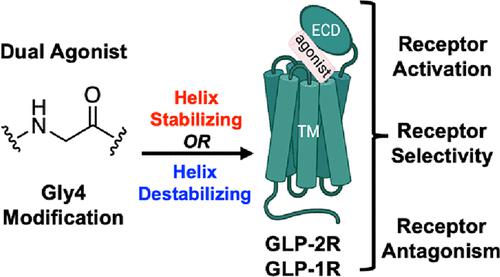当前位置:
X-MOL 学术
›
J. Am. Chem. Soc.
›
论文详情
Our official English website, www.x-mol.net, welcomes your feedback! (Note: you will need to create a separate account there.)
Differential Responses of the GLP-1 and GLP-2 Receptors to N-Terminal Modification of a Dual Agonist
Journal of the American Chemical Society ( IF 15.0 ) Pub Date : 2023-05-26 , DOI: 10.1021/jacs.3c01628 Ruslan Gibadullin 1 , Brian P Cary 1 , Samuel H Gellman 1
Journal of the American Chemical Society ( IF 15.0 ) Pub Date : 2023-05-26 , DOI: 10.1021/jacs.3c01628 Ruslan Gibadullin 1 , Brian P Cary 1 , Samuel H Gellman 1
Affiliation

|
Class B1 G protein-coupled receptors (GPCRs), collectively, respond to a diverse repertoire of extracellular polypeptide agonists and transmit the encoded messages to cytosolic partners. To fulfill these tasks, these highly mobile receptors must interconvert among conformational states in response to agonists. We recently showed that conformational mobility in polypeptide agonists themselves plays a role in activation of one class B1 GPCR, the receptor for glucagon-like peptide-1 (GLP-1). Exchange between helical and nonhelical conformations near the N-termini of agonists bound to the GLP-1R was revealed to be critical for receptor activation. Here, we ask whether agonist conformational mobility plays a role in the activation of a related receptor, the GLP-2R. Using variants of the hormone GLP-2 and the designed clinical agonist glepaglutide (GLE), we find that the GLP-2R is quite tolerant of variations in α-helical propensity near the agonist N-terminus, which contrasts with signaling at the GLP-1R. A fully α-helical conformation of the bound agonist may be sufficient for GLP-2R signal transduction. GLE is a GLP-2R/GLP-1R dual agonist, and the GLE system therefore enables direct comparison of the responses of these two GPCRs to a single set of agonist variants. This comparison supports the conclusion that the GLP-1R and GLP-2R differ in their response to variations in helical propensity near the agonist N-terminus. The data offer a basis for development of new hormone analogues with distinctive and potentially useful activity profiles; for example, one of the GLE analogues is a potent agonist of the GLP-2R but also a potent antagonist of the GLP-1R, a novel form of polypharmacology.
中文翻译:

GLP-1 和 GLP-2 受体对双重激动剂 N 端修饰的差异反应
B1 类 G 蛋白偶联受体 (GPCR) 共同响应多种细胞外多肽激动剂,并将编码的信息传递至胞质伙伴。为了完成这些任务,这些高度移动的受体必须响应激动剂而在构象状态之间相互转换。我们最近表明,多肽激动剂本身的构象迁移性在 B1 类 GPCR(胰高血糖素样肽 1 (GLP-1) 的受体)的激活中发挥作用。研究表明,与 GLP-1R 结合的激动剂 N 末端附近的螺旋和非螺旋构象之间的交换对于受体激活至关重要。在这里,我们询问激动剂构象迁移率是否在相关受体 GLP-2R 的激活中发挥作用。使用激素 GLP-2 的变体和设计的临床激动剂格列鲁肽 (GLE),我们发现 GLP-2R 对激动剂 N 末端附近的 α 螺旋倾向的变化相当耐受,这与 GLP-1R 的信号传导形成鲜明对比。结合激动剂的完全 α-螺旋构象可能足以用于 GLP-2R 信号转导。GLE 是 GLP-2R/GLP-1R 双激动剂,因此 GLE 系统能够直接比较这两种 GPCR 对单组激动剂变体的反应。该比较支持以下结论:GLP-1R 和 GLP-2R 对激动剂 N 末端附近螺旋倾向变化的反应不同。这些数据为开发具有独特且潜在有用的活性特征的新激素类似物提供了基础;例如,其中一种 GLE 类似物是 GLP-2R 的有效激动剂,也是 GLP-1R 的有效拮抗剂,这是一种新型的多药理学。
更新日期:2023-05-26
中文翻译:

GLP-1 和 GLP-2 受体对双重激动剂 N 端修饰的差异反应
B1 类 G 蛋白偶联受体 (GPCR) 共同响应多种细胞外多肽激动剂,并将编码的信息传递至胞质伙伴。为了完成这些任务,这些高度移动的受体必须响应激动剂而在构象状态之间相互转换。我们最近表明,多肽激动剂本身的构象迁移性在 B1 类 GPCR(胰高血糖素样肽 1 (GLP-1) 的受体)的激活中发挥作用。研究表明,与 GLP-1R 结合的激动剂 N 末端附近的螺旋和非螺旋构象之间的交换对于受体激活至关重要。在这里,我们询问激动剂构象迁移率是否在相关受体 GLP-2R 的激活中发挥作用。使用激素 GLP-2 的变体和设计的临床激动剂格列鲁肽 (GLE),我们发现 GLP-2R 对激动剂 N 末端附近的 α 螺旋倾向的变化相当耐受,这与 GLP-1R 的信号传导形成鲜明对比。结合激动剂的完全 α-螺旋构象可能足以用于 GLP-2R 信号转导。GLE 是 GLP-2R/GLP-1R 双激动剂,因此 GLE 系统能够直接比较这两种 GPCR 对单组激动剂变体的反应。该比较支持以下结论:GLP-1R 和 GLP-2R 对激动剂 N 末端附近螺旋倾向变化的反应不同。这些数据为开发具有独特且潜在有用的活性特征的新激素类似物提供了基础;例如,其中一种 GLE 类似物是 GLP-2R 的有效激动剂,也是 GLP-1R 的有效拮抗剂,这是一种新型的多药理学。



























 京公网安备 11010802027423号
京公网安备 11010802027423号